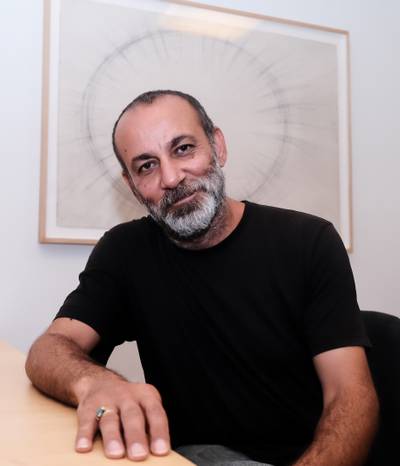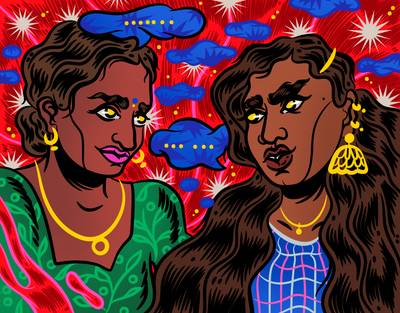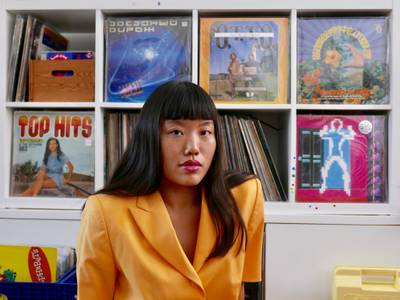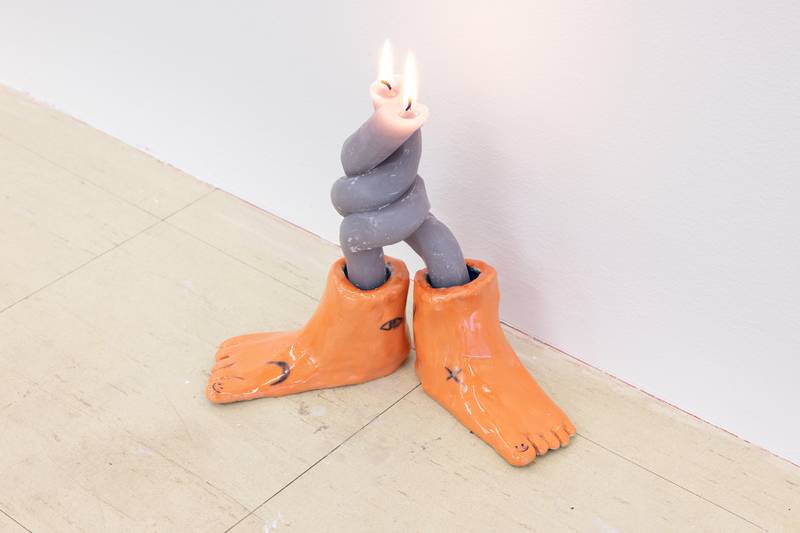

fire snuggle - ceramic candle holder, hugging candles, 2020. Image courtesy of SIC.
Katie Lenanton (she/her) has worked within, outside of, and counter to institutions, aiming to understand, corrupt, and change their ways of working. She strives to practice curatorial responsibility. In 2018, she began researching and building alternative institutional structures through the intersectional feminist curatorial collective Feminist Culture House.
Dear Bogna,
Hey, so Elham and Vidha asked that I conduct an interview with you, reflecting on your recent solo exhibition, Fragile Hug, (which was installed at SIC Space from 22.01–21.02.21). They hoped it could be critical and analytical—not afraid of asking difficult questions—but also able to emanate the warmth and familiarity of a conversation amongst friends.
I think we both got slightly nervous about this; there are many possible conversational pathways we could roam. I prepared through procrastination: by reading Fair Play by Tove Jansson, which is a collection of later-in-life short stories grounded in her long-term romance with Tuulikki Pietilä.
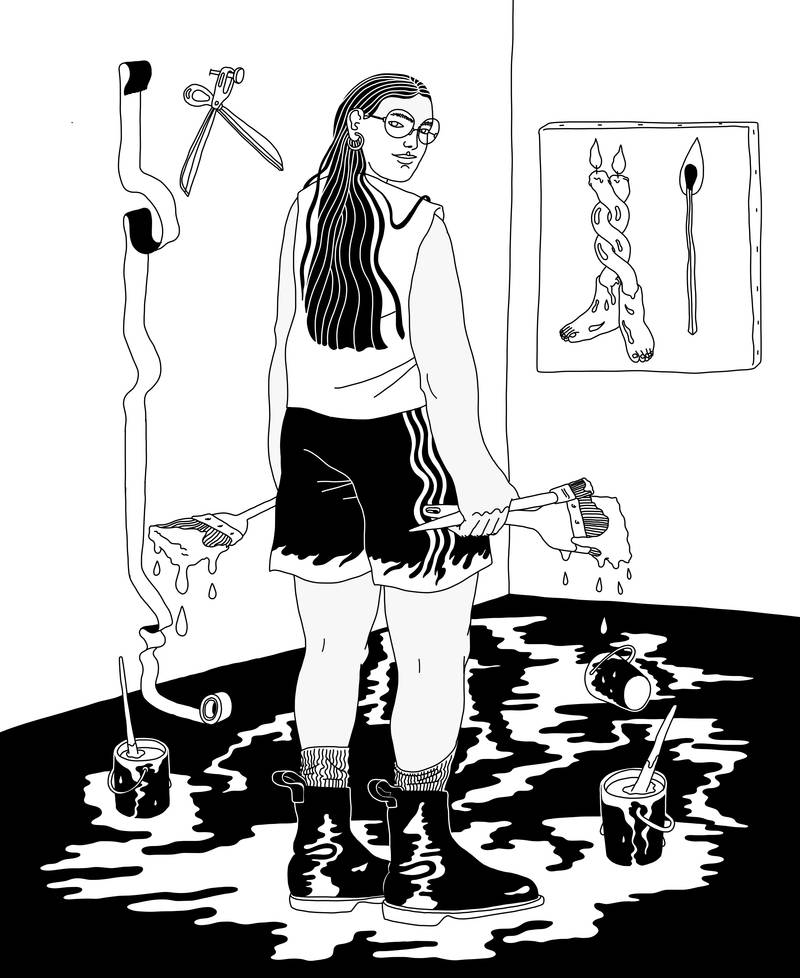

Edith Hammar, Portrait of Bogna Luiza Wiśniewska, 2021, digital
We chatted afterwards and I tried to share how it made me feel—comforted, calm, steady. Friendship found a form in these life-fragments. Their partnership was more than the sum of reconstructed and remembered parts. The way of being together contained deep unspoken understanding, patience, and support, but not to the exclusion of all others. It is inseparable: lovefriendship from friendshiplove.
When preparing, I also thought about (and googled the etymology of) my role. What is it to be the conductor, the one who conducts? I think their role is one of both leading and accompanying, guiding the togetherness, signalling a way.
Conduct is a doublet of conduit. I hadn’t known this term “doublet”, but it’s used in linguistics to mean a language-twin. It gestures to evident kinship—there is a shared and discernable root, but also a divergence. Maybe if we’re words we’d be doublets? Our practices and lives both interwoven but wandering.
Some years ago I used this word conduit when asked to describe my understanding of what a curator does. Its accompanying mental image was matter passing through a duct: enclosed, contained, guided, transient. While serving this purpose, the curator-conduit is also spongey. Things and people pass through but permeate, soak into you, become memories.
In searching for a way to conduct a conversation that balances critical distance and intimacy, I decided to procrastinate some more, and go through the archive of images we’ve sent each other in messenger, since we became friends in May 2017. I’m guiding the conversation using a (small) selection of these as prompts.
Love & hugs, Katie xxx
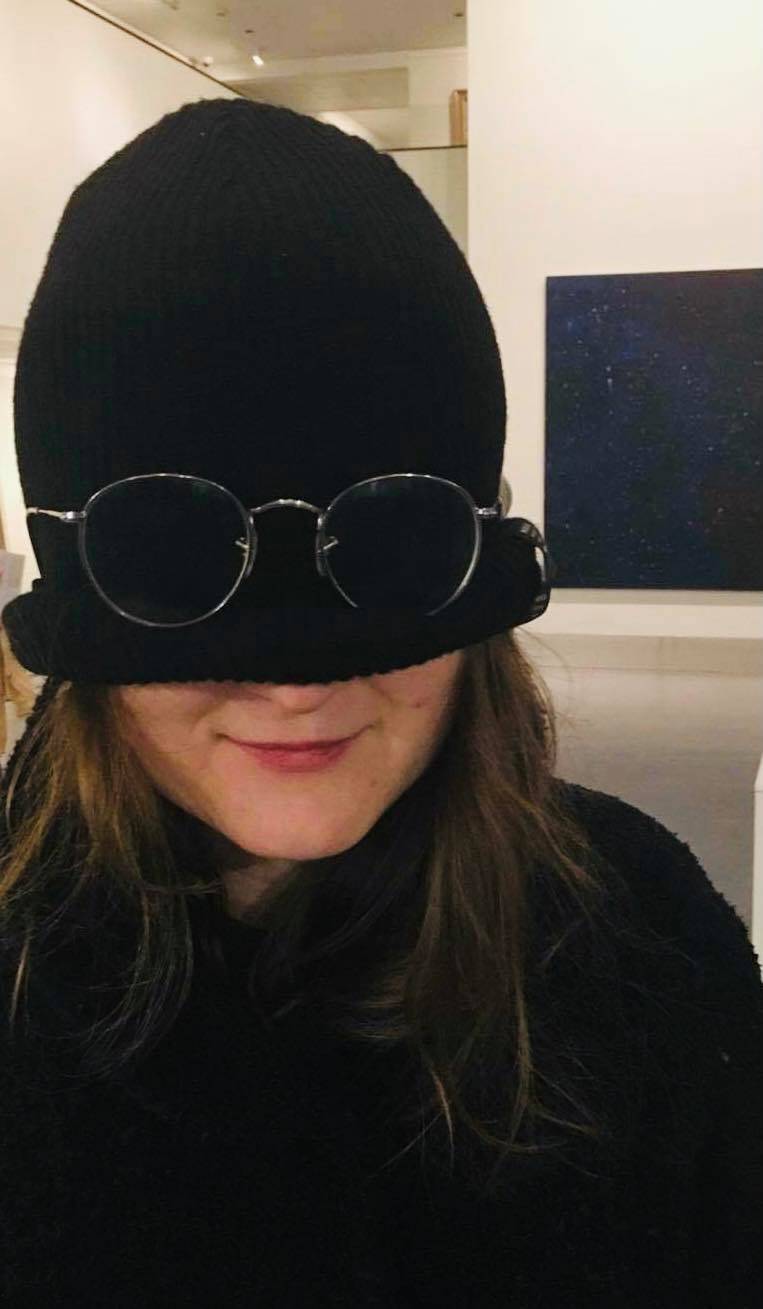

Bogna in Riihimäki, 2017. Image courtesy of Katie.
KATIE: This portrait is from an exhibition opening adventure, a few months after we met in 2017. I chose this to start because it’s iconic you, the smile and the glasses. It’s a bit of an obvious read, but you are shrouded. Do you know this word shrouded?
BOGNA: No, I don’t know.
Actually, maybe that’s a bit creepy. A shroud is a cloth used to cover a tomb, or actually a body… but anyway, I mean that you’re concealed, or the curtains are drawn, and I don’t know what’s underneath. What do I know about you here?
I look sneaky in that picture. But I remember we had a sneaky kind of adventure, going around this museum and checking out all the objects. When we began to hang out, it started pretty intensely, going wildly to all the openings. And when I found out you have Polish roots, it was straightaway to pierogi, sharing recipes and other food inspirations. And we were each other’s wing people, cruising and checking out art in different places, trying to find some adventures. I remember how I felt about that, it was like an instant friendship crush. That was pretty intense.
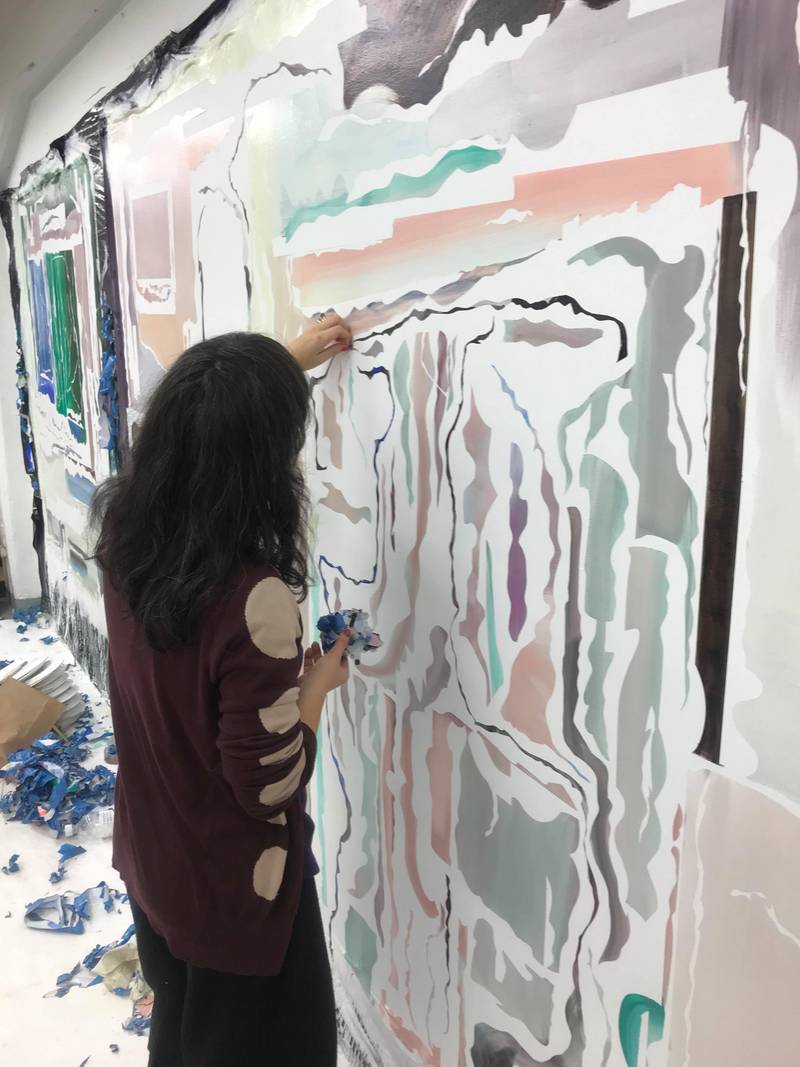

Small Reveals in Bogna’s studio, 2019. Image courtesy of Bogna.
Yeah, I felt the same intensity… it was a good beginning. Here I’m “helping” you remove masking tape as part of the painting process.
Why do you say helping like that [with that emphasis]?
Because actually, I’m totally getting off on the satisfying process…
Ah okay!
… and the surprise reveal, so it’s more like you are gifting me a pleasure moment I never knew I wanted. If we were describing this moment biographically, then we are preparing to make an exhibition together in Riga, having been invited by Kaspars and Martta from 427 Gallery. I’m mentioning this because now I’ve been around and part of your preparations for three exhibitions—427 was the first—and the Fragile Hug preparations at SIC for sure had these overwhelming moments of uncertainty, but I felt like you created steady ground for yourself. The work was quite gentle, and small-ish.
I think at some point, I accepted the subtleness in it, surprisingly. As you know, it wasn’t easy to make this exhibition, there were so many doubts, thoughts, classic kinds of chaos. But then I’m really happy that I accepted the intimate scale of this exhibition. All the small objects that I have been doing: ceramics at home, paintings in my studio. I didn’t go overboard, sometimes that happens to me when I’ve tried to do something big or loud.
Yeah. I remember early on you saying you wanted to spend weeks in the gallery making wall paintings, painting the windows and scratching back into it…
Now I’m super happy that I didn’t. Being there installing, being in this space, when I brought the works in I realised, “Oh, it’s enough”. I had to take some works away. But that quite often happens. The original ideas were so different. My fantasy of the exhibition was louder, definitely. But so many other things happened on the way, and I adjusted, they [the works] adjusted. And now for the first time, I’m totally, surprisingly, happy after the exhibition.
There are many small, intimate, and personal gestures there.
Yeah, I talked with many people and got some messages, and it seems people kind of found their own intimate moments [in the exhibition], or the gestures that they needed in this time somehow. It was nice to hear that people could really relate, it was really kind. I was happy about that.
The parts of a body that are used for touch were very present in the works.
Yeah. I guess this need for touch is so present now, It’s something I noticed not only in my work but all around. And when I’m producing [new work] I wanted to give this feeling of tangible fingers or tongues, this feeling of touch.
Yeah, maybe it’s kind of comforting to see things touching? In lieu of being able to touch freely, it’s comforting to see work touching freely… you can project.
I think, yeah, definitely.
And then, thinking of touching fingers…
Yeah, I loved that you found this!
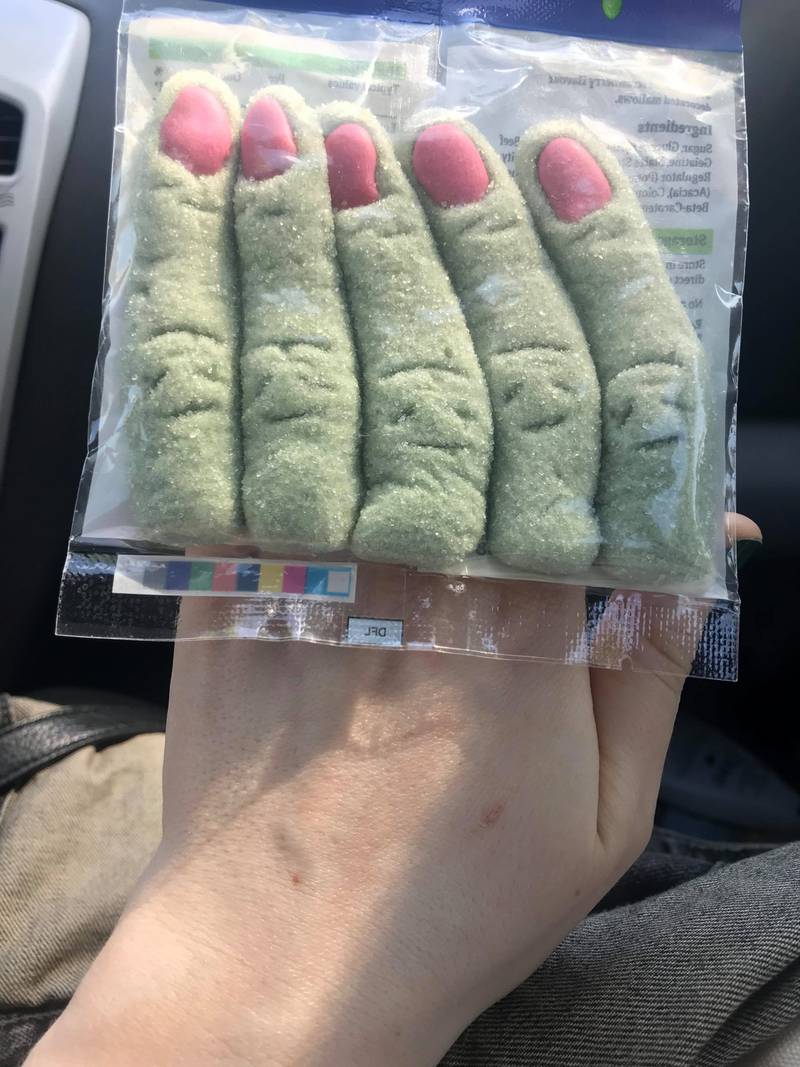

Gift from Bogna, 2018. Image courtesy of Bogna.
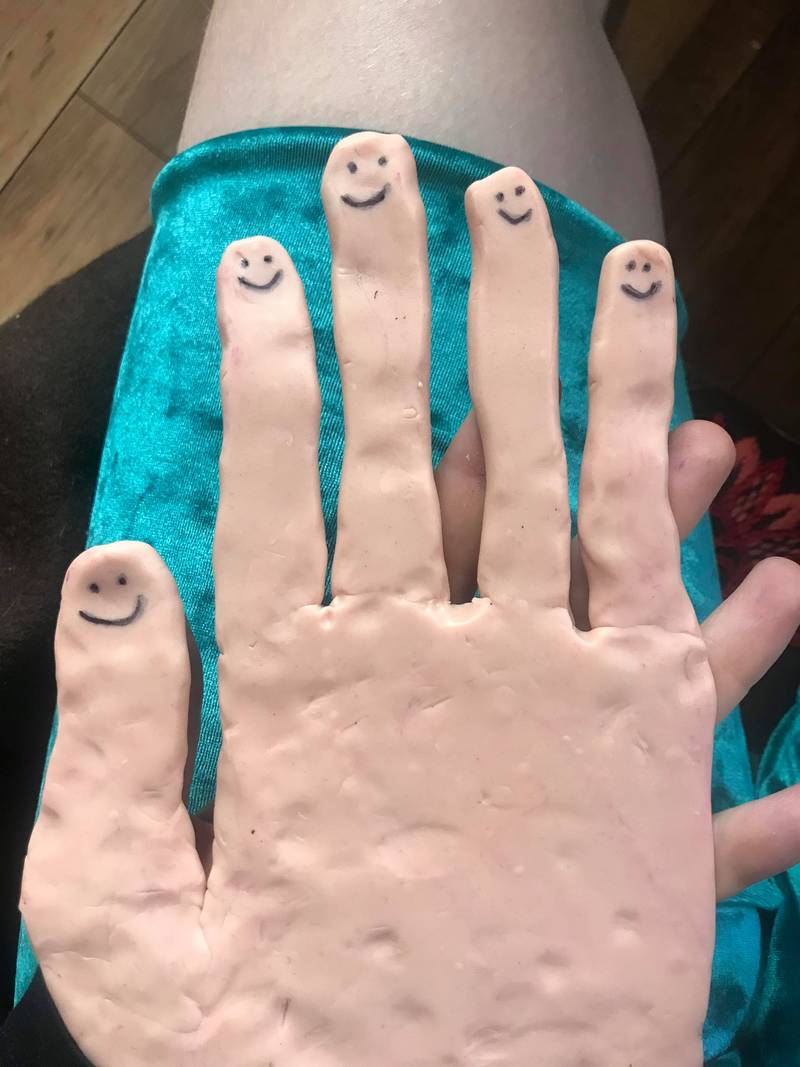

Hand prototype, 2019. Image courtesy of Bogna.
Yeah! It was fun to find this sculpture and realise it found a different form in SIC.1
Do you see the smiles in the candy?
I hadn’t, but now I do! The knuckles are like little grinches or ninja turtles or something.
Yeah. Is that still in your place? You have lots of hand objects.
Yeah, it’s still here, I’ll never eat it [laughs]. The question I prepared for these images is: What are hands for?!
Oh, touching, connecting. What is the correct word? When I’m close to Aleks [partner] I’m always [gestures] she gets giggly?
Ticklish?
Yeah, it’s all over. Yeah, when I’m close to somebody I like to caress, it becomes automatic in my behaviour, I love this.
There’s some research about caring for premature babies, if they’re stroked gently and feel skin-on-skin contact, they grow quicker. I agree that feeling someone else’s hands stroke your body is a great pleasure.
[Noises of agreement]
Now I’m patting Snooz [dog companion] and she just happy-groaned.
So nice to have your back scratched.
Yes [sighs]. The next group of pictures are hugs I’ve sent you recently. At your mini-opening (max 5 people!) we were talking about missing hugs, and greeting people, and I particularly missed the soft silly pleasure of hugging someone while both wearing big winter jackets.
It’s as if you would hug a marshmallow. You’re somehow not hugging the whole body, it’s more fluffy and un-bodily. I remember we talked about the [exhibition] title in a studio visit, I hadn’t had the best day. And you asked some good questions, is the hug fragile, are you the one giving fragile hugs? Is the creature so fragile that it needs a hug? It helped me see things from many perspectives.
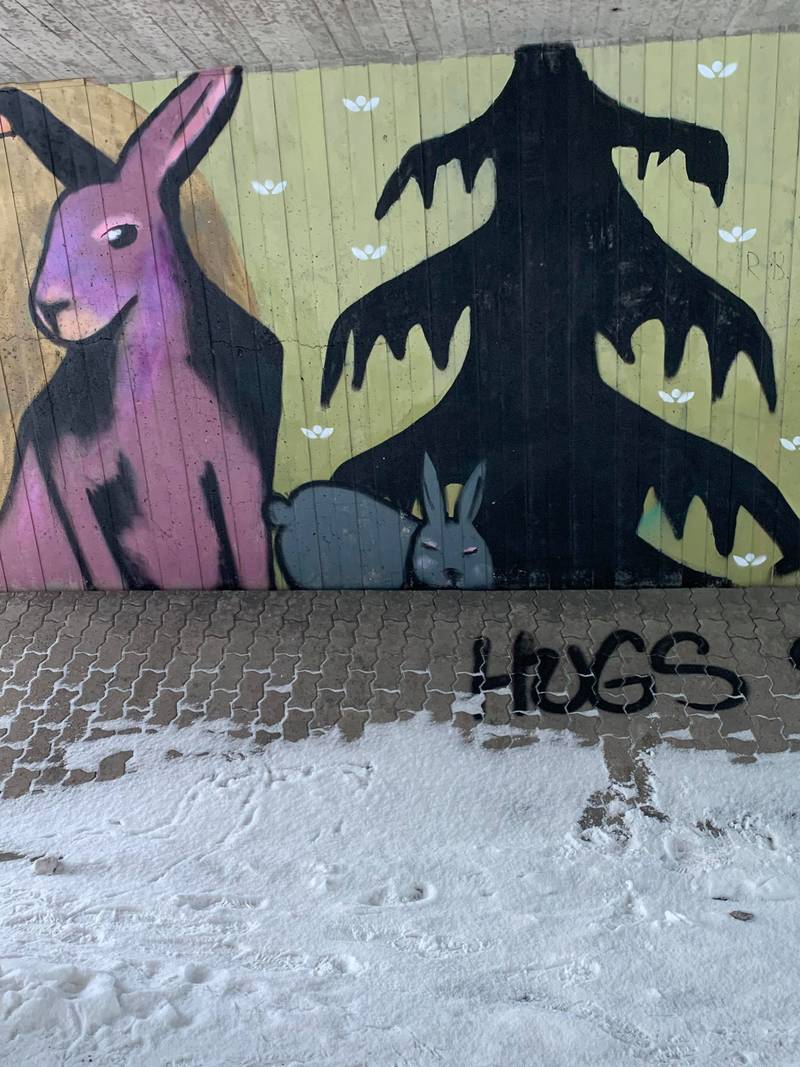

Hugs in Myllypuro underpass, 2020. Image courtesy of Katie.
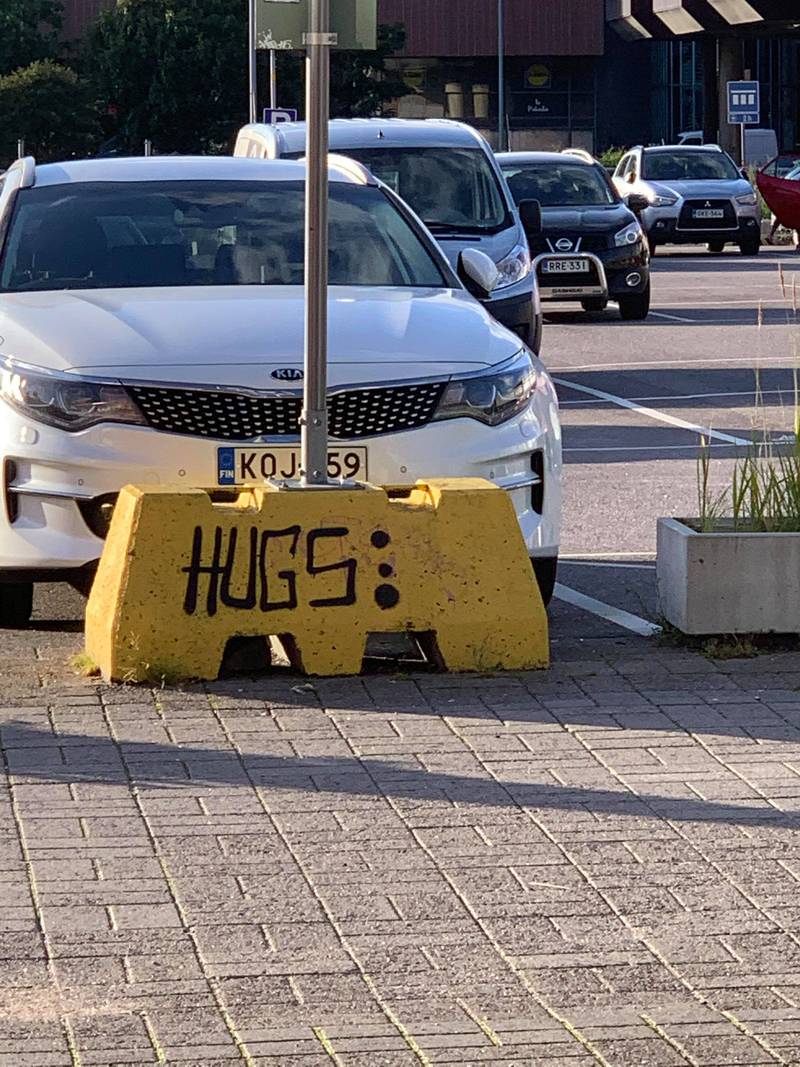

Hugs in a forgotten car park, 2020. Image courtesy of Katie.
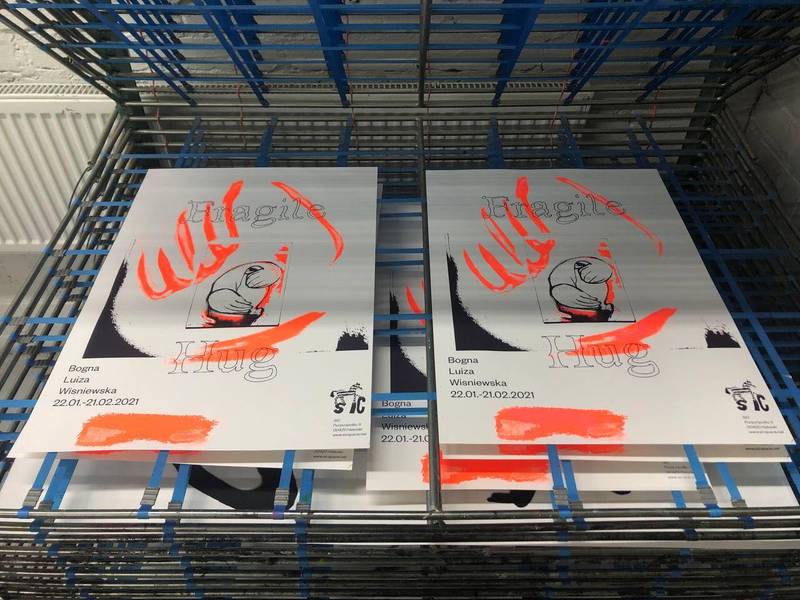

Fragile Hug serigraph poster, 2021. Image courtesy of SIC.
Yeah, I guess a hug is inherently fragile, it’s a gesture that’s never going to be firm, it breaks at some point.
Yeah, but it can also go on and on—Edith [Hammar, who drew Bogna’s portrait] gives really firm hugs! Like instant support.
Mmmmm.
I was surprised with this first painting [for the exhibition] that I did, which is on the serigraph poster. I haven’t done this kind of work for some time, which is I guess representative, and a little bit cartoony. But it seemed kind to me, and I felt surprisingly good about it. I’m such a huggy person.
Yeah, you are. Did you ever listen to this riot grrrl band, Huggy Bear?
No!
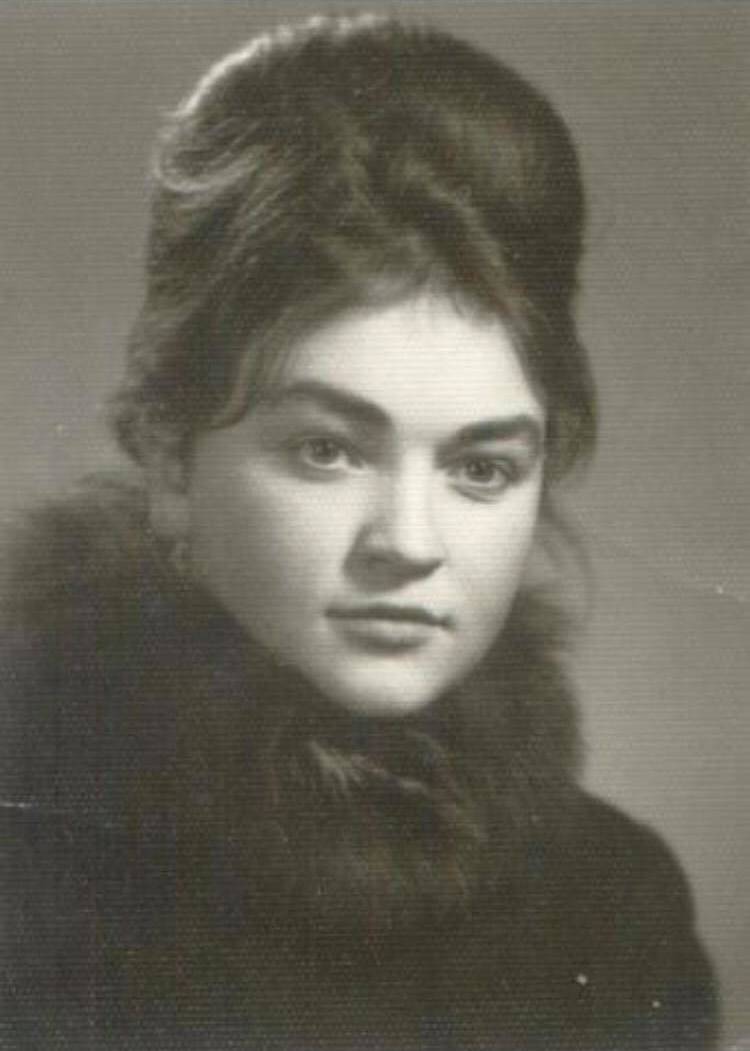

Babcia, 2018. Image courtesy of Bogna.
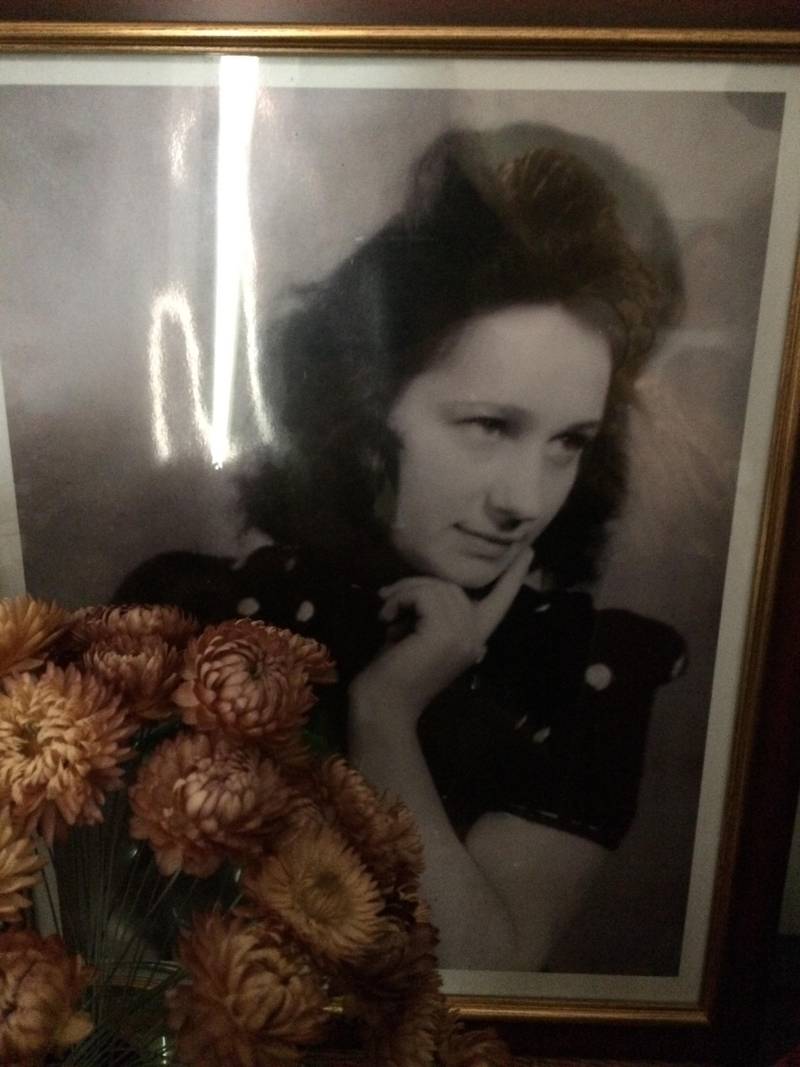

Babcia, 2019. Image courtesy of Katie.
I’ll share a link, I remember they were good.
So the next images I found were of our babcias [grandmothers]. You sent me this quite early on in our friendship, and a few years later I was back home and then I found a picture of mine. Seeing these made me think of this word doublet again, and our shared [Polish] roots. Now we go to quite an intimate and private space, of grief and grieving, which you were navigating and within while making Fragile Hug.
Yeah, [I was grieving] for another grandma, not the grandma in this image. The timing [of the exhibition] wasn’t really good. At the same time, it was good, but it was hard.
Yeah.
It was kind of helping me, working on that exhibition meant I didn’t go deep into grieving, I could in a sense focus on other things and try not to… yeah. It’s weird to be so far, trying to do this grieving thing, but just being connected with your family through the internet.
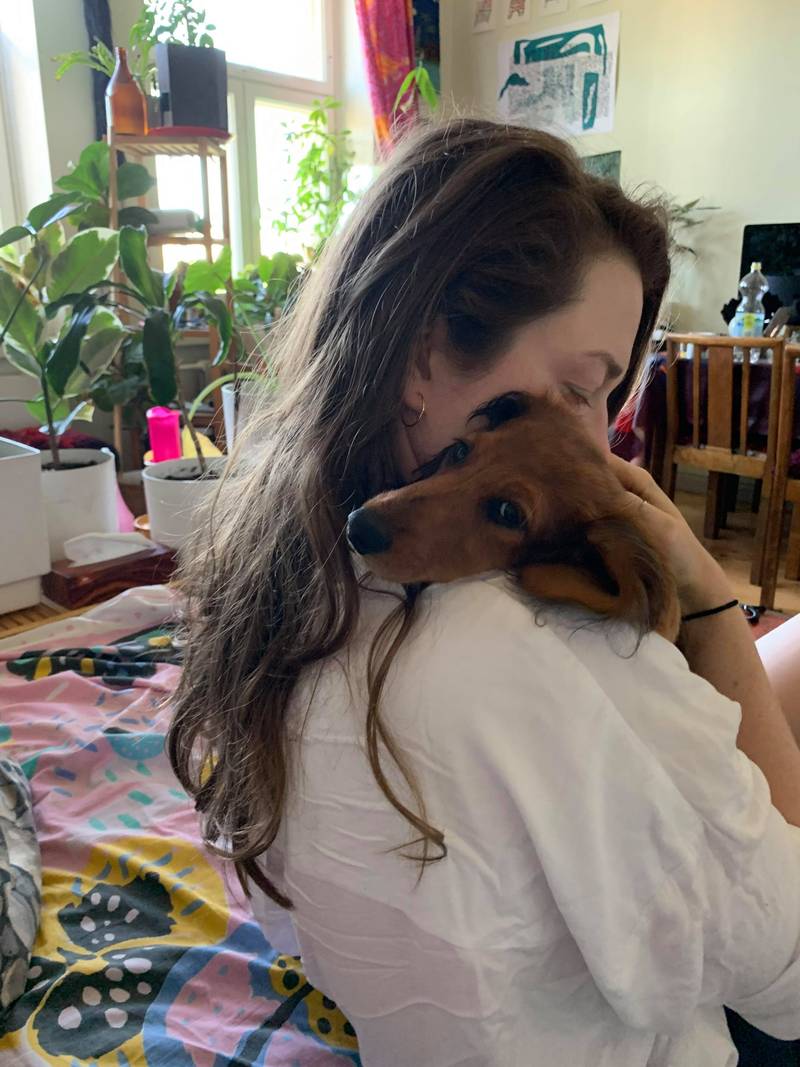

Bogna and Snoozle, 2019. Image courtesy of Katie.
Yeah. I understand.
But yeah, we have the babcia connection, and also the typical babcia behaviour, like treating others, and taking care, and trying to be hospitable.
And bargains, of course.
Yes, bargains! There is a kind of babcia swag.
Babcia swag! That’s a good title for the article [laughs]. Okay, so after this babcia sadness, we should have a small puppy break. Let’s look at this embrace between you and baby Snooz.
That one is so huggable!
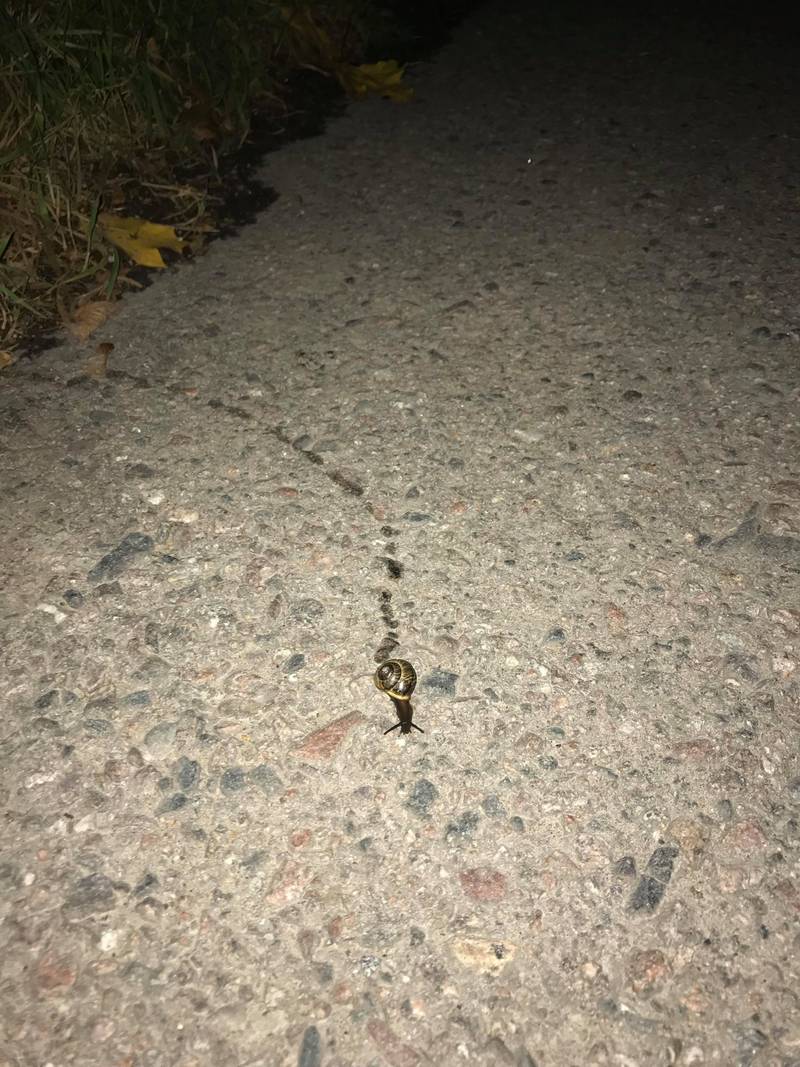

Snail trail, 2018. Image courtesy of Bogna.
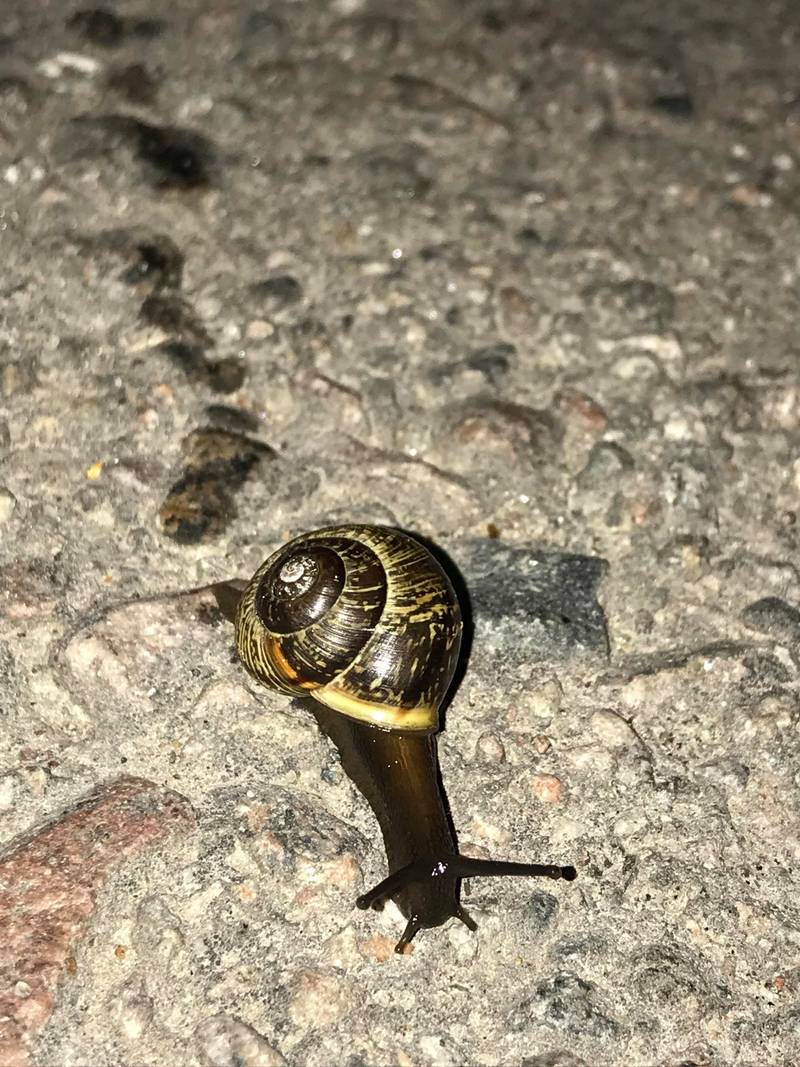

Snail trail (detail), 2018. Image courtesy of Bogna.
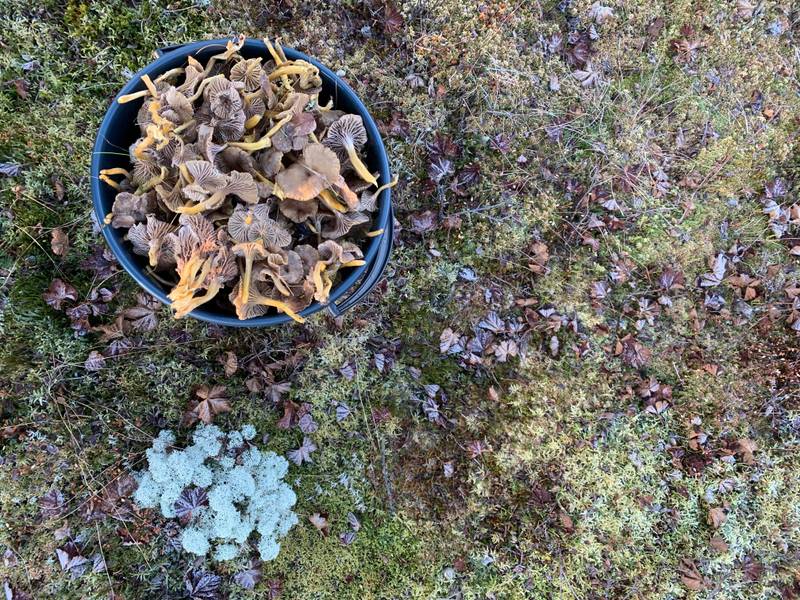

Maybe 1/15 of the mushrooms we picked at Mustarinda, 2020. Image courtesy of Bogna.


entwined gentleness in progress, 2021. Image courtesy of Bogna.
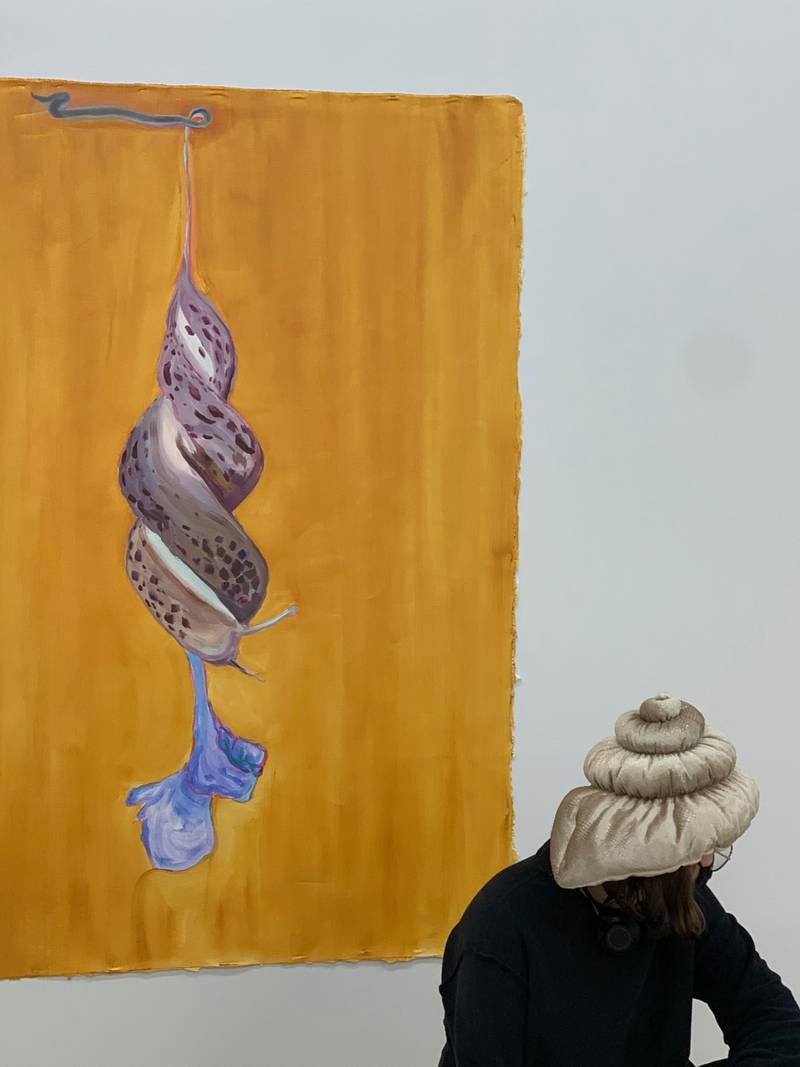

Vernissage Bogna and entwined gentleness, 2021. Image courtesy of Katie.
And then we go from hugs to slugs 🙃. You shared this snail trail in 2018. And then I realised that snails and slugs were quite present when we were in Mustarinda [residency] together this past November—finding them in mushrooms, and understanding that’s a choice, to do that intense mushroom cleaning work to find and extract them.
Yes.
And then you were a bit stuck with this big painting, and we watched this sexy leopard slug video. And then recently I found this hat in the kirppis the day before your opening. So I wondered… hmm maybe this is building up to a question about painting, and what painting can do?
I think I found a meme or something with slug hugging. And then you came and shared this Attenborough video of slugs, and we watched it in my studio, and I was just amazed. It was such a beautiful kind of nature dance, swirling, and just so erotic. I was like, wow! Who knew that these slimy things would get so tender with each other? I guess I got infatuated by that. And I just wanted to make a painting of that, this moment of slimy things being beautiful, amazingly, coming together.
Yeah, so then I guess painting is like a memory tool for a moment of excitement?
And pleasure. I think so. Definitely.
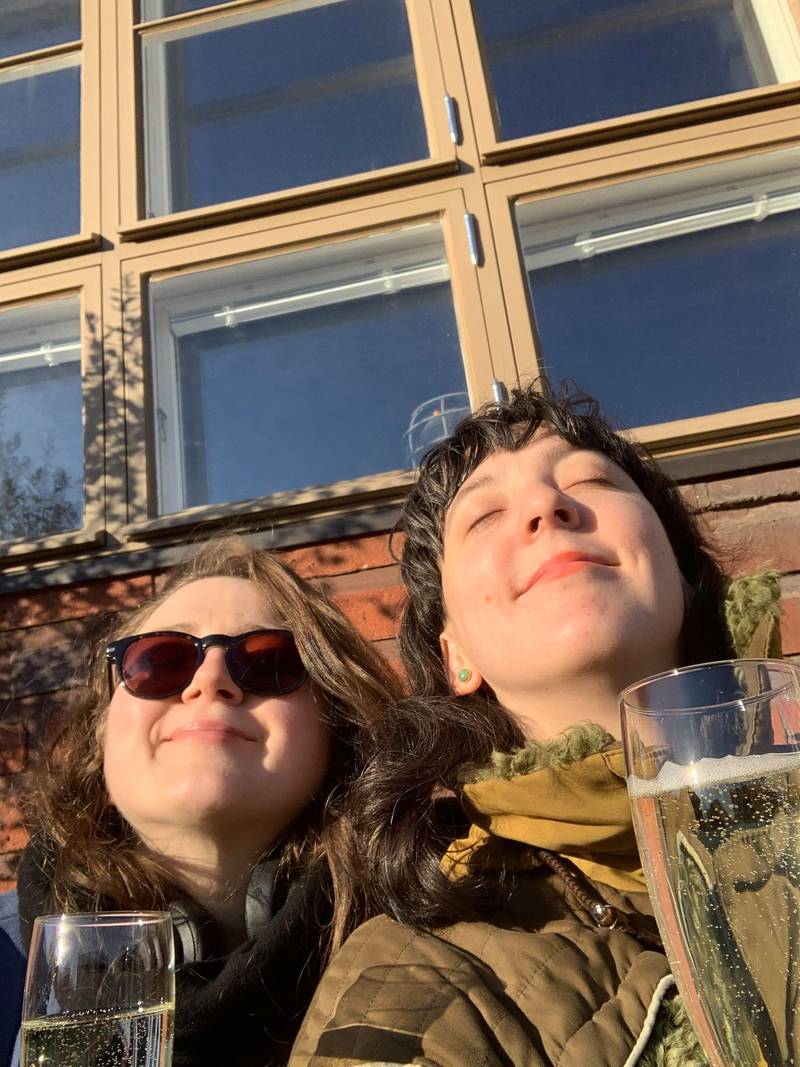

Ottaa arskaa, 2019. Image courtesy of Katie.
I recently learned the [Finnish] phrase ottaa arskaa [take the sun], and that’s what we’re doing here, seizing the first spring terrace moment from a few years ago. We’ve also discussed how making dumplings during the winter solstice will bring good luck, and I’m already sending you rhubarb recipes. I’m thinking or wondering about the rhythms that you work with, or that you look forward to, or the rhythms that have been adopted or feel important this past year. [These questions are] all variations on a theme.
I think the rhythm I’d like to have never happens. I’m always just rolling with a situation, and quite often doing many things at the last moment. But since I started working with ceramics, I have to be more scheduled, which is nice. I adjust to the rhythms of different techniques.
Sometimes I do things that aren’t made for an exhibition, and it’s an amazing feeling—it’s a cliche—but just doing for [the sake of] doing. It helps me make plans for other works without scheduling them, which feels nice. I guess I’ve also had difficulties with painting in itself, [sometimes] I’m not sure what I want to do, and why I want to do it, and what does it bring? And then, of course, at the same time it’s pure enjoyment, and again confusion. But I want to go towards the direction that I slowly found while making this exhibition: intimate responses to some moments in my life. It’s simple. This is it.
Yeah. I always thought that painting also has this preparation part of it, like rituals to prepare.
The rituals are nice, like preparing the canvases gives you time to work on the simple, mechanical, repetitive things. It’s a good type of work, and you have some schedule and some kind of rhythm.
Going back to the rhythms, I was also just thinking of daily life as well as art life. Those few weeks when fava beans are around, we’ve just had laskiaispulla season… those moments in the year you’re craving or looking forward to.
Always summer.
[laughs] Ha okay, like everyone else.
There are lots of small things, food things. Night rhythms. I’m a person who likes to sleep and then stay up the whole night. I love coming back home from the studio at three or four in the morning, walking and listening to music when the city’s empty. And you’re tired but then you’re hyped that you’ve done some work.
Yeah, I’m the same, waking up and working in the early morning. It’s difficult to sleep when the thing is burning inside you.
Yeah. Oooh I just scrolled through the images and saw Bernie.
Ha, okay let’s wrap things up with some silliness… and preface this by saying I’m not hugely active on Instagram, sometimes I go a few days without checking it.
It [the Bernie inauguration meme] started appearing everywhere when we were installing. I sent it to our SIC group, and then I sent it to you.
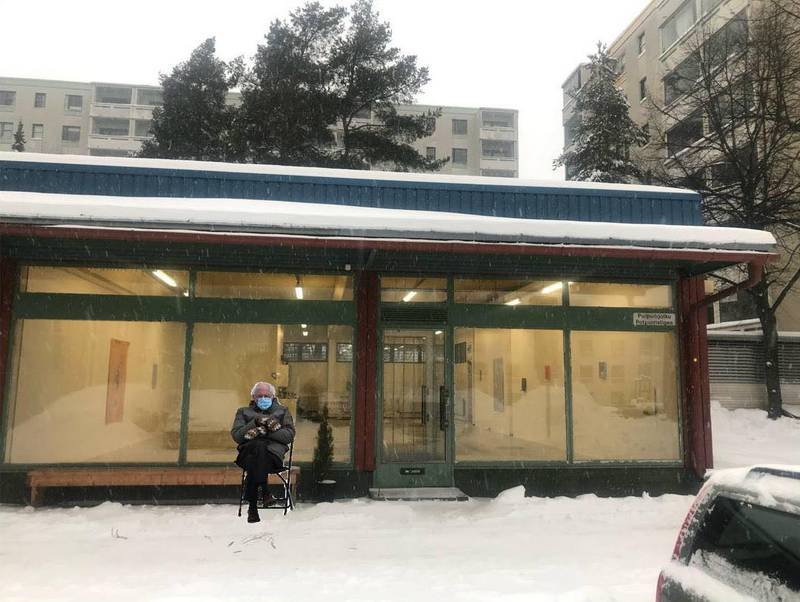

Bernie at SIC, 2021. Image courtesy of Bogna.
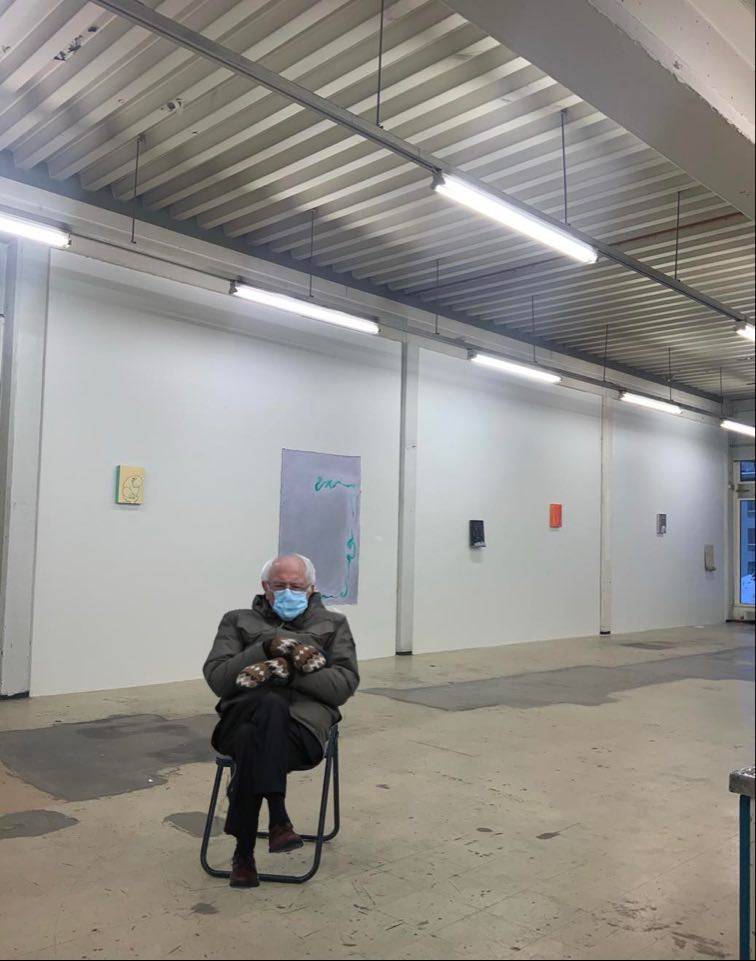

Bernie in SIC, 2021. Image courtesy of Bogna.
And I totally didn’t understand what was going on [laughs]. I seriously thought that you let some older person in from the cold to hang out inside with you. And I remember thinking, oh now they’ve moved inside, that’s pretty kind of Bogna to let this stranger in the gallery, hearts pic, but I hope they’re not forcing her to engage in awkward conversation.
Yeah. And that [welcoming a stranger] would actually be something I’d do… and give them a chair to sit on.
That’s kind of uncomfortable-looking, but yes. Anyway, I guess this situates the exhibition in a moment that everyone who’s on the internet will forever remember: the day before fragile hug opened, Bernie in mittens was everywhere.
Exactly.
And there was change going on! A presidential transition.
Finally, yes!
So the exhibition started with Bernie, and finished with this video you sent on the final day, of the candle friends burning to the end.
Yes! I had been trying to make it last, only lighting it when someone entered the space.
Perfect timing! And perfect for the season.
Yes, I realised I have been working with warmth in different ways, finding forms to recognise warmth. Like in everyday objects like candles, and the burned [wood] drawings are made with warmth, the ceramic tongues are a bit like flames… kinda hugging the fire. And you burn the ceramics…
Omg [stunned]. Wow okay, I feel silly for not writing a question about that very obvious link between all these works. Fire!
[laughs, waggles fingers magically] It’s all connected! Last year I got really into making candles as gifts, twisting and shaping them. Then this is a pretty intimate gift for Aleks, her feet and tattoos, and these two creatures fused together somehow.
So nice that they could hang out in SIC! And that they lasted.
Yeah, maybe Fragile Hug was a way to try and make some things and moments last when they are needed.
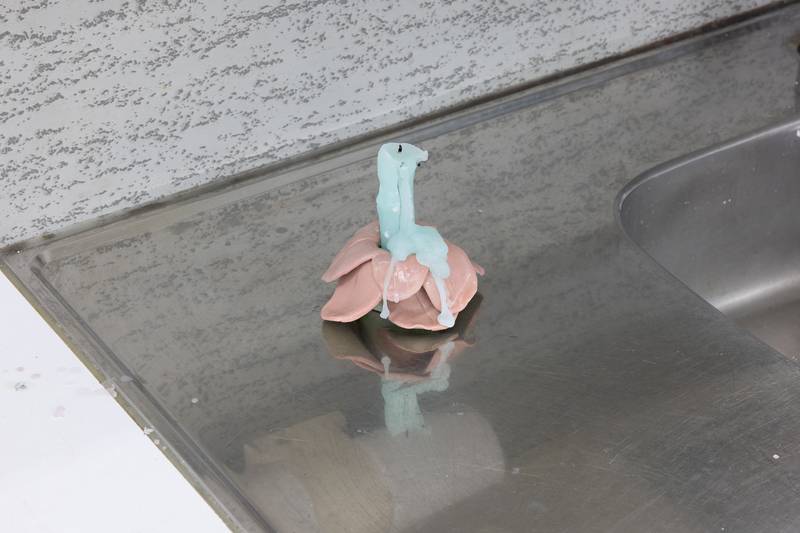

mrrrrr - ceramic candle holder, 2021
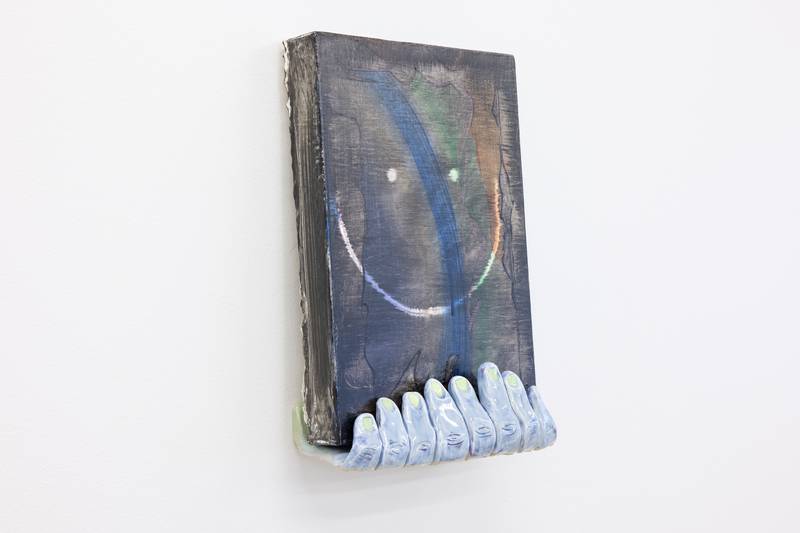

just keep swimming - oil painting, a4, ceramic shelf, 2021
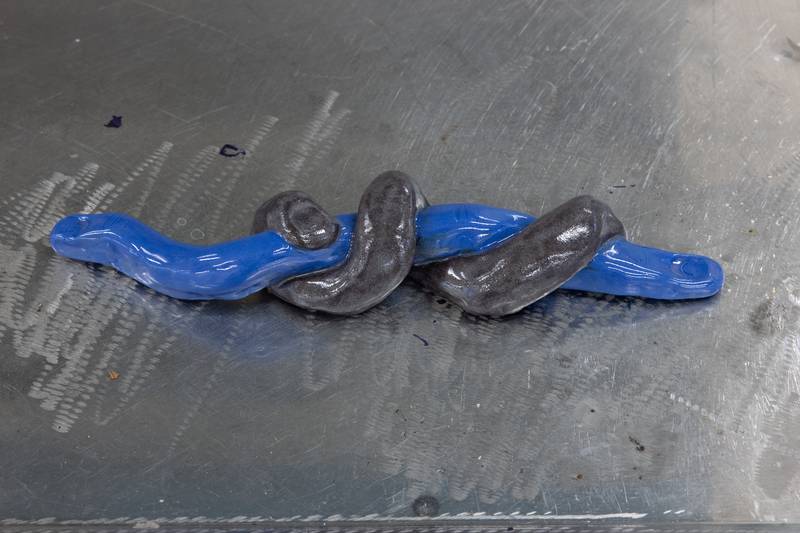

fingers crossed - blue&black porcelain, 2021


entwined gentleness - oil painting, 115x162, 2021; blurry affection - oil painting, a3, 2021
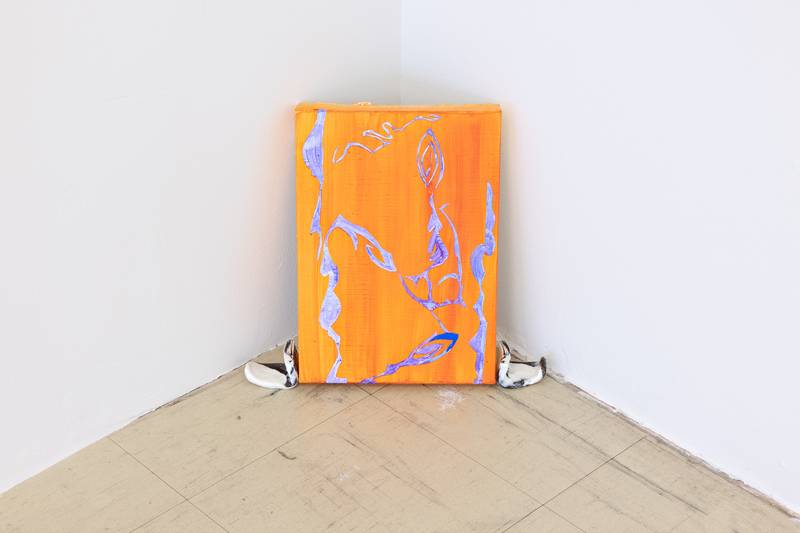

tangible warmth - oil painting, a4, 2021
